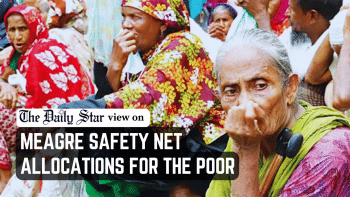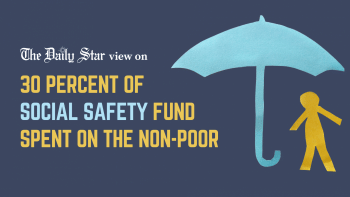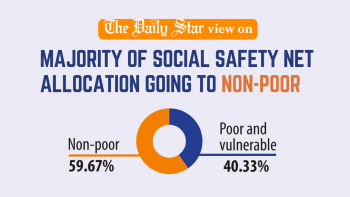Overhaul the social safety net for real impact

After years of criticism and chronic inefficiencies, the authorities finally seem poised to restructure the social safety net system in the FY2025-26 budget expected to be unveiled in early June, as per a report by this daily. We welcome this shift, as it shows some intent to address long-standing concerns about the system's inflated numbers, overlapping schemes, and misdirected allocations. But good intentions alone are not enough. The redesign must result in a more targeted and impactful intervention that genuinely supports the poor.
According to finance ministry officials, the number of schemes under the social safety net will be trimmed from 140 to fewer than 100, while 38 programmes will be grouped as "pro-poor" targeting the most vulnerable. The total allocation is expected to be Tk 95,908 crore—up from Tk 90,468 crore in the current budget—covering an additional 10 lakh beneficiaries. Small increases in monthly allowances are also expected across key cash assistance programmes like allowances for old age, the widow, deserted and destitute women, the physically challenged, mother and child benefits, etc. While these increases seem modest at the individual level, the real challenge lies in ensuring proper selection and enforcement so that any assistance reaches the most deserved beneficiaries.
For too long, our social safety net system has been weighed down by misclassification, corruption, and inefficiency. As we highlighted on various occasions in the past, especially during the tenure of the ousted Awami League government, the inclusion of retirement benefits and interest payments on savings certificates in the social safety budget inflated its total allocation, creating a misleading picture of state commitments to the poor. These expenditures accounted for 30 percent of the total allocation for FY2023-24, as per an assessment by CPD last year. The think tank also assessed that the share of "compatible" programmes under the social safety net bracket declined from 62.2 percent in FY2009-10 to 29.2 percent in FY2023-24.
The planned restructuring, therefore, must reverse this state of affairs. Merely shaving off irrelevant schemes is not enough. What we need is a fundamental restructuring of how these programmes are designed and implemented. Beneficiary selection must be transparent, data-driven, and insulated from political interference. Leakages must be plugged through digitisation and stronger oversight. And above all, allocations must be large enough to actually support families and individuals facing economic hardship.
With the FY2026 budget around the corner, the government has an opportunity to make the system fit for purpose as a support structure for the vulnerable segments, with the goal of making them eventually self-reliant. Only then can the safety net serve its purpose of poverty alleviation. To that end, we urge the government to consult experts and build on previous research, including the findings of its own taskforce submitted in January, before finalising reform decisions.


 For all latest news, follow The Daily Star's Google News channel.
For all latest news, follow The Daily Star's Google News channel. 











Comments